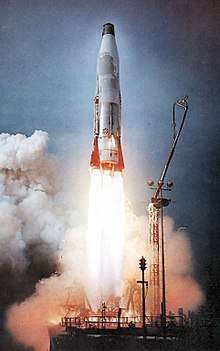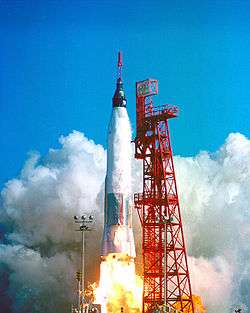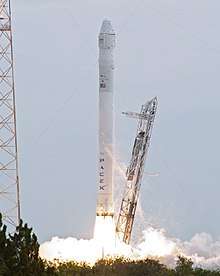Medium-lift launch vehicle
A medium-lift launch vehicle (MLV) is a rocket launch vehicle that is capable of lifting between 2,000 to 20,000 kg (4,400 to 44,100 lb) of payload into low Earth orbit (LEO).[1] An MLV is between small-lift launch vehicles and heavy-lift launch vehicles.
Rated launch vehicles
| Vehicle | Origin | Manufacturer | Mass to LEO (kg) |
Mass to other orbits (kg) |
Launches | Status | First flight | Last flight |
|---|---|---|---|---|---|---|---|---|
| Vostok | RSC Energia | 4,730 | 163 | Retired | 1958 | 1991 | ||
| Saturn I | Chrysler & Douglas | 9,000 | 10 | Retired | 1961 | 1965 | ||
| Atlas-Centaur | Lockheed | 5,100 | 61 | Retired | 1962 | 1983 | ||
| Titan II GLV | Martin | 3,580 | 12 | Retired | 1964 | 1966 | ||
| Titan IIIC | Martin | 13,100 | 3,000 to GTO 1,200 to TMI |
36 | Retired | 1965 | 1982 | |
| Molniya-M | TsSKB-Progress | 2,400 | 280 | Retired | 1965 | 2010 | ||
| Proton-K | Khrunichev | 19,760 | 311 | Retired | 1965 | 2012 | ||
| Soyuz original | OKB-1 | 6,450 | 32 | Retired | 1966 | 1975 | ||
| R-36 Tsyklon | Yuzhmash | 4,100 | 236 | Retired | 1967 | 2009 | ||
| Soyuz-L | OKB-1 | 5,500 | 3 | Retired | 1970 | 1971 | ||
| Titan IIID | Martin | 12,300 | 22 | Retired | 1971 | 1982 | ||
| Soyuz-M | OKB-1 | 6,600 | 8 | Retired | 1971 | 1976 | ||
| Soyuz-U | TsSKB-Progress | 6,900 | 786 | Retired | 1973 | 2017 | ||
| Feng Bao 1 | Shanghai Bureau №2 | 2,500 | 8 | Retired | 1973 | 1981 | ||
| Long March 2A | CALT | 2,000 | 4 | Retired | 1974 | 1976 | ||
| Titan IIIE | Martin Marietta | 15,400 | 3,700 to TMI | 7 | Retired | 1974 | 1977 | |
| Delta 3920–5920 | Douglas | 3,452–3,848 | 30 | Retired | 1980 | 1990 | ||
| N-II[2] | Mitsubishi | 2,000 | 8 | Retired | 1981 | 1987 | ||
| Soyuz-U2 | TsSKB-Progress | 7,050 | 72 | Retired | 1982 | 1995 | ||
| Long March 2C | CALT | 3,850 | 1,900 to SSO | 54 | Operational | 1982 | ||
| Atlas G | Lockheed | 5,900 | 7 | Retired | 1984 | 1989 | ||
| Long March 3 | CALT | 5,000 | 1,340 to GTO | 14 | Retired | 1984 | 2000 | |
| Zenit-2 | Yuzhnoye | 13,740 | 36 | Retired | 1985 | 2004 | ||
| H-I | Mitsubishi | 3,200 | 1,100 to GTO | 9 | Retired | 1986 | 1992 | |
| Long March 4A | SAST | 4,000 | 2 | Retired | 1988 | 1990 | ||
| Ariane 4 | Aérospatiale | 7,600 | 4,800 to GTO | 116 | Retired | 1988 | 2003 | |
| Delta II | United Launch Alliance | 6,100 | 2,170 to GTO 1,000 to HCO |
156 | Retired | 1989 | 2018 | |
| Atlas I, II, III | Lockheed | 5,900–8,686 | 2,340–4,609 to GTO | 80 | Retired | 1990 | 2005 | |
| Long March 2E | CALT | 9,200 | 7 | Retired | 1990 | 1995 | ||
| Long March 2D | SAST | 3,300 | 1,300 to SSO | 40 | Operational | 1992 | ||
| PSLV | ISRO | 3,800 | 1,200 to GTO 1,750 to SSO |
50 | Operational | 1993 | ||
| H-II / IIS | Mitsubishi | 10,060 | 4,000 to GTO | 7 | Retired | 1994 | 1999 | |
| Long March 3A | CALT | 6,000 | 2,600 to GTO 5,000 to SSO |
27 | Operational | 1994 | ||
| Long March 3B | CALT | 11,200 | 5,100 to GTO 5,700 to SSO |
12 | Retired | 1996 | 2012 | |
| Delta III | Boeing | 8,290 | 3,810 to GTO | 3 | Retired | 1998 | 2000 | |
| Dnepr | Yuzhmash | 4,500 | 2,300 to GTO 550 to TLI |
22 | Retired | 1999 | 2015 | |
| Zenit-3 | Yuzhmash | 7,000 | 6,160 to GTO | 46 | Operational | 1999 | ||
| Long March 2F | CALT | 8,400 | 3,500 to GTO | 13 | Operational | 1999 | ||
| Long March 4B/4C | SAST | 4,200 | 1,500 to GTO 2,800 to SSO |
55 | Operational | 1999 | ||
| H-IIA | Mitsubishi | 10,000 | 6,000 to GTO | 39 | Operational | 2001 | ||
| Soyuz-FG | TsSKB-Progress | 6,900 | 70 | Retired | 2001 | 2019 | ||
| GSLV Mk.I | ISRO | 4,000 | 2,150 to GTO | 6 | Retired | 2001 | 2010 | |
| Atlas V | United Launch Alliance | 18,810 | 8,900 to GTO | 83 | Operational | 2002 | ||
| Soyuz-2/Soyuz ST | TsSKB-Progress | 8,200 | 3,250 to GTO 4,400 to SSO |
73 | Operational | 2006[lower-alpha 1] | ||
| Long March 3B/E | CALT | 11,500 | 5,500 to GTO 6,900 to SSO |
37 | Operational | 2007 | ||
| Long March 3C | CALT | 9,100 | 3,800 to GTO 6,500 to SSO |
15 | Operational | 2008 | ||
| H-IIB | Mitsubishi Heavy Industries | 19,000 | 8,000 to GTO | 9 | Retired | 2009 | 2020 | |
| Falcon 9 v1.0 | SpaceX | 10,450 | 4,540 to GTO | 5 | Retired | 2010 | 2013 | |
| GSLV Mk.II | ISRO | 5,000 | 2,700 to GTO | 7 | Operational | 2010 | ||
| Antares 110–130 | Orbital Sciences | 5,100[3] | 1,500 to SSO | 5 | Retired | 2013 | 2014 | |
| Falcon 9 v1.1 | SpaceX | 13,150 | 4,850 to GTO | 15 | Retired | 2013 | 2016 | |
| Soyuz-2-1v | TsSKB-Progress | 2,800 | 1,400 to SSO | 4 | Operational | 2013 | ||
| Falcon 9 Full Thrust (partially reusable)[4] | SpaceX | 15,600+[5] | 7,075+[6] to GTO | 63 | Operational | 2015 | ||
| Antares 230 | Northrop Grumman | 7,800[3] | 3,000 to SSO | 3 | Operational | 2016 | ||
| Long March 7 | CALT | 13,500 | 5,500 to SSO | 2 | Operational | 2016 | ||
| GSLV Mk.III | ISRO | 10,000 | 4,000 to GTO | 4 | Operational | 2017[lower-alpha 2] | ||
| Angara 1.2 | Khrunichev | 3,500[7] | 0 | Operational | 2018[8][lower-alpha 2] | |||
| H3 | Mitsubishi Heavy Industries | 4,000 | 0 | Under development | 2020 | |||
| Irtysh | Progress Rocket Space Centre | 18,000 | 5,000 to GTO | 0 | Under development | 2022 | ||
| Nuri | KARI | 2,600 (LEO, 300km) | 1,500 to LEO (600~800km) | 0 | Under development | 2021 | ||
| Ariane 6 (A62) | ArianeGroup | 10,350 | 5,000 to GTO | 0 | Under development | 2020 | ||
| Unified Launch Vehicle | Indian Space Research Organization | 4,500-15,000 | 1,500-6,000 to GTO | 0 | Under development | 2022 |
- A suborbital test flight was conducted in 2004, without the upper stage.
- A suborbital test flight was conducted in 2014, without the upper stage.
Gallery
 Launch of an Atlas B intercontinental ballistic missile
Launch of an Atlas B intercontinental ballistic missile Launch of the first American crewed orbital space flight Atlas and Friendship 7
Launch of the first American crewed orbital space flight Atlas and Friendship 7 A Falcon 9 v1.0 launches with an uncrewed Dragon spacecraft, 2012
A Falcon 9 v1.0 launches with an uncrewed Dragon spacecraft, 2012 Falcon 9 booster tank at the SpaceX factory, 2008
Falcon 9 booster tank at the SpaceX factory, 2008.jpg) Launch of GSLV Mk lll D2 with GSAT-29 from SHAR, India.
Launch of GSLV Mk lll D2 with GSAT-29 from SHAR, India.
gollark: `def sort(list): return [] # returns a sorted list, O(1) time`
gollark: Even better sorting algorithm: pass through the list unsorted, hope nobody notices the difference.
gollark: Still O(n), unfortunately, but doesn't require a universe destroying thingy, which can be expensive to obtain.
gollark: Okay, better sorting algorithm: scan through the list. Remove any element which is not in order.
gollark: I suppose I'll settle for O(log n).
See also
- Sounding rocket, suborbital launch vehicle
- List of orbital launch systems
- Small-lift launch vehicle, capable of lifting up to 2,000 kg to low Earth orbit
- Heavy lift launch vehicle, capable of lifting between 20,000 and 50,000 kg to low Earth orbit. (Includes Ariane 5)
- Super Heavy lift launch vehicles, capable of lifting more than 50,000 kg (110,000 lb) of payload into LEO
- Comparison of orbital launch systems
- Comparison of orbital rocket engines
- Comparison of space station cargo vehicles
- Rocket
References
- NASA Space Technology Roadmaps - Launch Propulsion Systems, p.11: "Small: 0-2t payloads, Medium: 2-20t payloads, Heavy: 20-50t payloads, Super Heavy: >50t payloads"
- "N-2". Encyclopedia Astronautica. Archived from the original on 8 November 2013. Retrieved 12 June 2013.
- Krebs, Gunter. "Antares (Taurus-2)". Gunter's Space Page. Retrieved 22 September 2018.
- "Capabilities & Services". SpaceX. 2015. Archived from the original on 7 October 2013. Retrieved 3 May 2016.
- "SpaceX and Cape Canaveral Return to Action with First Operational Starlink Mission". NASASpaceFlight.com. 11 November 2019. Retrieved 11 November 2019.
- Krebs, Gunter. "Telstar 19V (Telstar 19 Vantage)". Gunter's Space Page. Gunter. Retrieved 7 August 2018.
- "Angara Launch Vehicle Family". Khrunichev State Research and Production Space Center. Retrieved 2 September 2018.
- Pietrobon, Steven (6 September 2018). "Russian Launch Manifest". Retrieved 11 September 2018.
Further reading
- Mallove, Eugene F. and Matloff, Gregory L. The Starflight Handbook: A Pioneer's Guide to Interstellar Travel, Wiley. ISBN 0-471-61912-4.
This article is issued from Wikipedia. The text is licensed under Creative Commons - Attribution - Sharealike. Additional terms may apply for the media files.